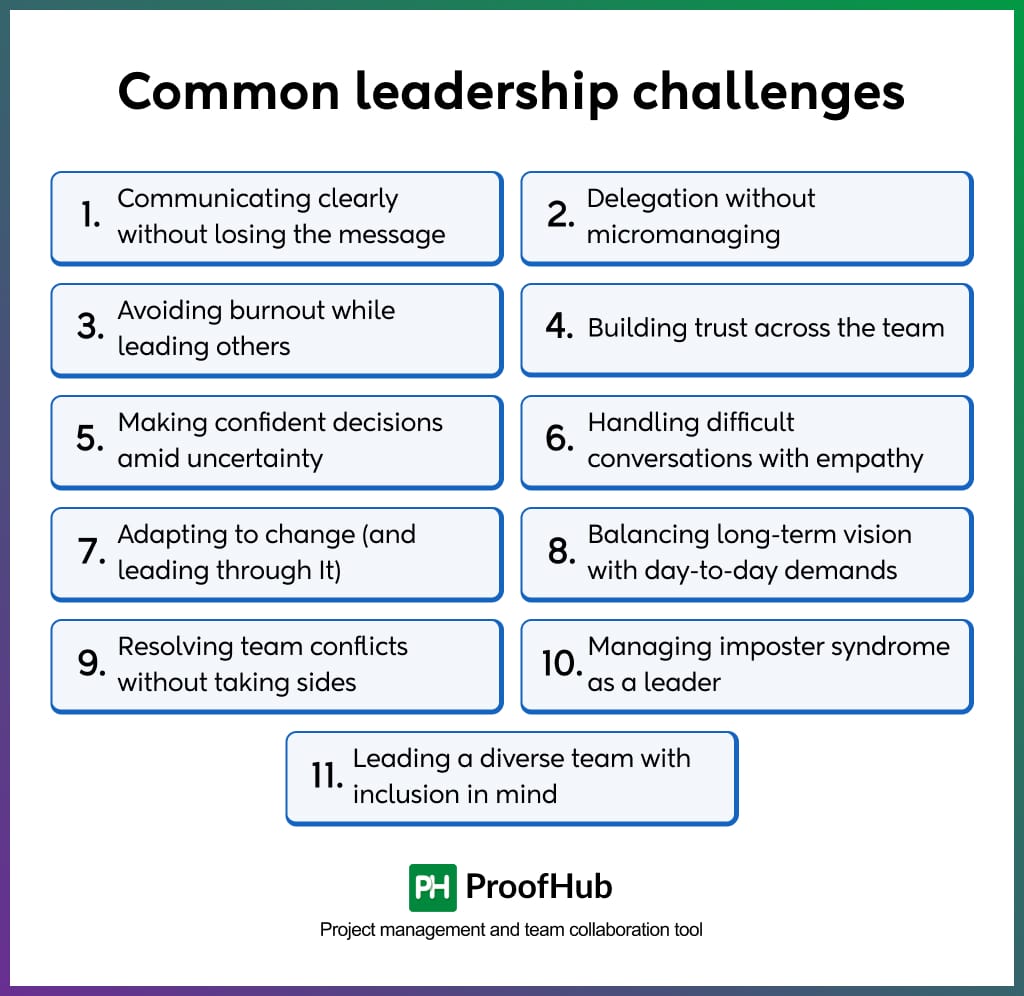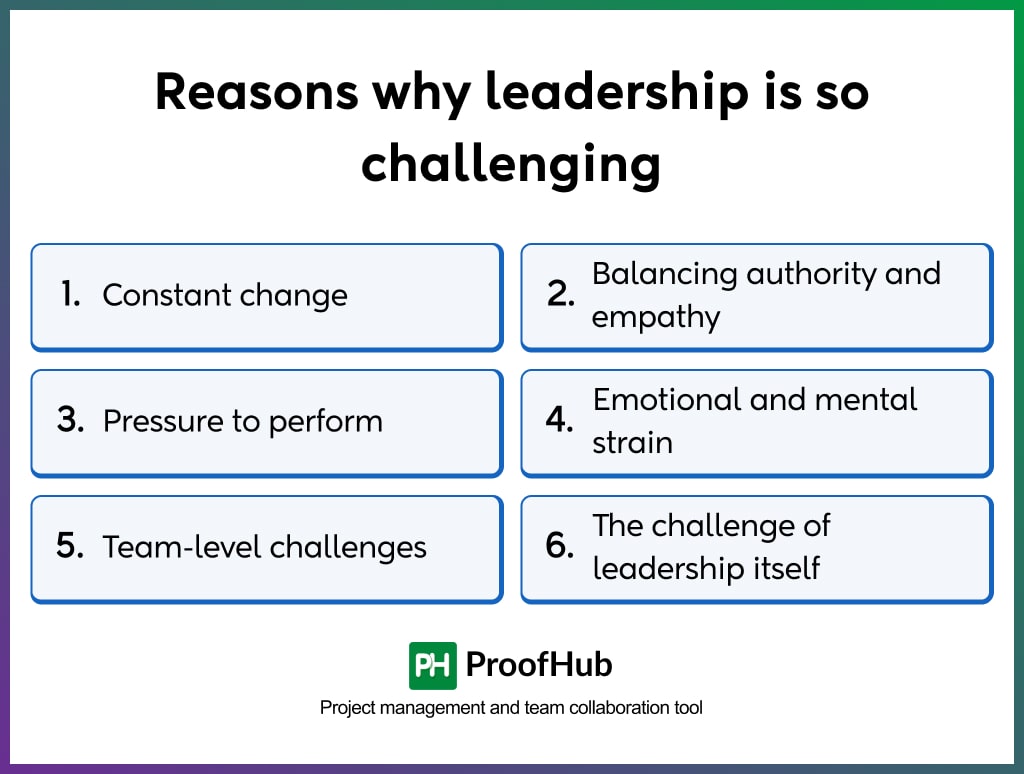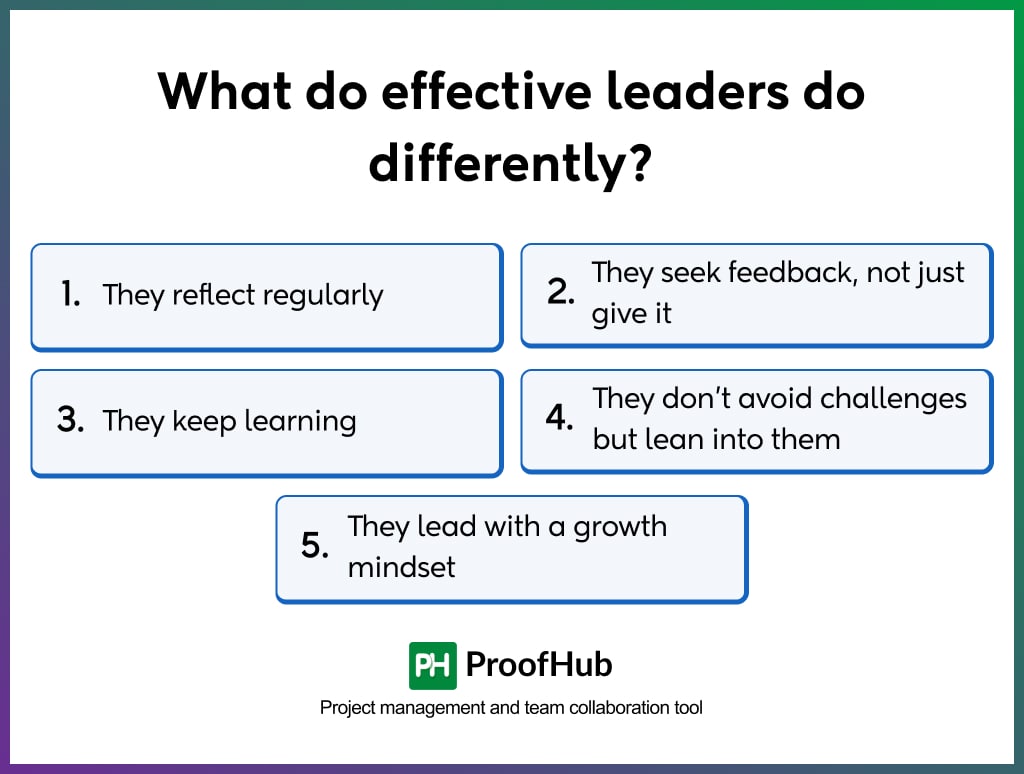No one tells you this when you step into a leadership role:
Leadership is not only about vision and strategy, it is about enduring constant pressure, tough choices, and moments of doubt you rarely admit out loud.
One minute you’re the motivator. Next, you’re managing conflict, racing against deadlines, and questioning if you’re doing any of it right.
Leadership is rewarding, but it is also relentless.
What separates effective leaders isn’t perfection; it is the ability to face challenges head-on, learn from them, and keep moving forward with purpose.
In this article, we will explore 11 common leadership challenges that show up time and again and how to overcome each one without losing team morale or long-term goals.
So, without wasting any time, let’s get started!
Common leadership challenges and how to tackle them
Every leader faces challenges, but the skilled ones don’t avoid them; they work through them. Here are some of the most common leadership challenges and how you can face them with confidence.

1. Communicating clearly without losing the message
Leaders are expected to communicate direction, goals, and feedback, yet messages often get misunderstood, misinterpreted, or missed entirely.
For instance, you announce a new process to your team. A week later, half the team is following it, the other half is confused, and no one is on the same page.
In leadership roles, communication gets filtered through urgency, assumptions, and team dynamics. Leaders often focus on what to say but forget to check how it’s received.
Here are some signs of poor communication:
- Mixed messages or contradictions.
- Unmet expectations or delays.
- Repeating yourself often or feeling like you have to.
How can you overcome this challenge?
- Practice active listening: Listen not just to respond, but to understand. Reflect back what you hear.
- Clarify intent vs. impact: Explain what you’re saying and why it matters. Also check how it is received or perceived by others.
- Ask better questions: Replace “Any questions?” with “What might be unclear here?” or “What do you need from me to move forward?”
- Use team communication tools: Tools like ProofHub allow you to centralize conversations, document feedback, and keep communication organized across the team.
Organize, manage, and collaborate seamlessly with ProofHub – All-in-one solution for projects, tasks, and teams Try it for free!
2. Delegation without micromanaging
Leaders often hesitate to delegate tasks to team members, fearing mistakes or loss of control.
For example, you assign a task, but check in constantly, tweak the work mid-way, and end up redoing parts yourself. The team becomes demotivated, and you are overworked.
Many leaders think, “It’s faster if I do it” or “If they mess up, I’ll look bad.” But doing everything yourself isn’t sustainable or empowering.
Some symptoms of poor delegation include:
- Team members avoid ownership.
- Projects bounce back and forth without progress.
- You feel overwhelmed and over-involved.
How can you overcome this challenge?
- Use the 70% rule: If someone can do it 70% as well as you, delegate it and guide them through the last 30%.
- Apply the Eisenhower Matrix: Sort tasks by urgency and importance. Delegate what’s urgent but not strategic.
- Build trust through small wins: Start with low-risk tasks. Let others succeed and grow into ownership.
- Use task management tools: These tools can help you create and assign tasks, set deadlines, and track progress, without hovering over every detail.
Discover our accumulated list of best task management tools to organize your tasks efficiently.
3. Avoiding burnout while leading others
Burnout, not even skip leaders. In fact, they often hide it behind high performance, until it finally breaks through.
You are constantly busy, making decisions all day, and left emotionally drained. You are physically present, but mentally exhausted.
Leaders carry not only their workload but the emotional and strategic weight of the team. Without boundaries, it adds up fast.
Here are a few red flags of burnout:
- Decision fatigue.
- Lack of motivation or emotional exhaustion.
- Disengagement from the team or work.
How can you overcome this challenge?
- Time-block for recovery: Protect blocks of time for focus and rest just like meetings.
- Say no with clarity: Decline tasks that don’t align with your role or priorities, kindly but firmly.
- Take mental resets: Step away. Use peer check-ins, breaks, or walks to re-center.
- Create space to reflect: Pause weekly to ask: What’s draining me? What’s energizing me?
4. Building trust across the team
Trust is foundational to team performance, and its absence results in disengagement, misalignment, and high turnover.
When leaders overpromise and underdeliver, avoid accountability, or skip follow-through, trust erodes.
Your team misses deadlines and becomes disengaged. You notice finger-pointing and vague accountability.
Here are a few reasons that weaken trust:
- Inconsistent follow-through.
- Unclear ownership.
- Lack of transparency.
How can you overcome this challenge?
- Establish follow-through rituals: Keep promises, close loops, and communicate outcomes.
- Develop an ownership mindset: Let team members lead small initiatives and own the results.
- Model vulnerability: Share challenges and ask for help. It sets the tone for openness and connection.
Building trust and alignment is central to effective team leadership. Learn what team leadership is.
5. Making confident decisions amid uncertainty
Leaders often struggle to make decisions when the roadmap is not clear and fear being wrong.
You delay a decision because data is incomplete. Team momentum stalls, and anxiety rises.
Why does it happen?
Leaders fear backlash, judgment, or costly mistakes, especially with conflicting input or pressure from above.
How can you overcome this challenge?
- Use decision frameworks: Try the 70/30 rule (act with 70% certainty) or the OODA loop (Observe, Orient, Decide, Act).
- Separate confidence from certainty: You don’t need to be 100% sure, just confident enough to move forward with your plan.
- Debrief decisions: After each major decision, review what worked and what didn’t. Build a learning loop.
6. Handling difficult conversations with empathy
Tough conversations, especially when it comes to performance issues, often get delayed because leaders fear upsetting the team or damaging relationships.
However, avoiding these conversations can result in frustration, resentment, and bigger issues down the line.
And, why does it happen?
Many leaders shy away from difficult discussions because they worry about the emotional impact, causing conflict, or not handling the conversation well.
This often stems from the desire to maintain peace, but in reality, this avoidance can harm the team dynamic, create misunderstandings, or even lead to larger issues that grow unnoticed.
How can you overcome this challenge?
- Use the SBI model: Use a structured method to communicate. The SBI model (Situation, Behavior, Impact) makes sure that feedback is focused on facts.
For example: “In today’s meeting (Situation), I noticed you interrupted multiple times (Behavior), which made it hard for others to share their ideas (Impact).” This helps avoid defensiveness and keeps the conversation objective.
- Pause > Reflect > Respond: Before jumping into a tough conversation, take a moment to center yourself.
Reflect on what you want to achieve from the conversation, whether it’s a behavior change, clarification, or a solution, and regulate your emotions. This way, you avoid reacting impulsively or getting caught up in the heat of the moment.
- Build a culture of honesty: Create an environment where giving and receiving feedback is a regular part of team culture.
Encourage open, honest, and respectful conversations where feedback is seen as a way for growth rather than a personal attack. This shifts the focus from fear to improvement.
7. Adapting to change (and leading through It)
Leading through change, whether it’s a new process, team structure, or tool, can be one of the toughest parts of leadership. Change often disrupts routines, creates uncertainty, and generates resistance. Even positive changes can cause stress if not handled with care.
Why does it happen?
Most people are wired to prefer stability. When change is sudden or poorly communicated, team members are blindsided, excluded from decisions, or unsure about their future.
Resistance often arises not from the change itself, but from a lack of clarity, involvement, or emotional safety. If the “why” is unclear or the change is imposed, leaders face hesitation, low morale, or even passive pushback.
How can you overcome this challenge?
- Start with open dialogue: Communicate early and transparently. Explain the reason for the change, who it affects, and how it supports the overall goals.
Encourage questions and acknowledge concerns; people want to be heard as much as informed.
- Create a clear roadmap: Break down the change into phases or milestones. Share what will happen and when, so the team knows what to expect.
Celebrate small wins along the way to show progress and boost confidence.
- Model flexibility: Leaders set the emotional tone during transitions. Show your team that it’s okay not to have all the answers at once.
Stay open to feedback, adjust when needed, and demonstrate a learning mindset. When you embrace change with calm and curiosity, others are more likely to follow.
8. Balancing long-term vision with day-to-day demands
One of the most common leadership challenges is staying focused on long-term goals while managing the pressure of daily operations.
Leaders often find themselves constantly responding to urgent issues such as emails, meetings, and minor setbacks, while their bigger strategic objectives remain sidelined.
Why does it happen?
Urgent tasks tend to demand immediate attention, while strategic work requires focus, planning, and deep thinking – things that are easily pushed aside during a busy day.
Without clear boundaries or prioritization systems, leaders become reactive instead of intentional. Over time, this results in stagnation, short-term thinking, and frustration over the lack of meaningful progress.
How can you overcome this challenge?
- Use weekly strategy check-ins: Set aside dedicated time (ideally once a week) to assess how your current activities align with your overall goals.
Ask yourself: “Am I working on what truly matters?” These check-ins keep you anchored in your long-term vision.
- Apply the Eisenhower Matrix: Categorize tasks by urgency and importance. Prioritize work that’s important but not urgent. Delegate or defer tasks that don’t align with your leadership role.
- Delegate execution to focus on direction: As a leader, your primary job is to provide clarity, direction, and vision, not to manage every detail.
Trust your team with the “how” so you can stay focused on the “why” and “what’s next.” Delegation frees up your time to think ahead and lead strategically.
9. Resolving team conflicts without taking sides
Conflict is inevitable in any team. But when it goes unresolved or is handled poorly, it damages collaboration, slows down progress, and lowers team morale.
Leaders often struggle to intervene without appearing biased or escalating the issue further.
Why does it happen?
Team members bring different communication styles, work habits, values, and expectations. When there’s a lack of clarity, trust, or mutual understanding, friction builds up.
Without a clear process for addressing tension, conflicts either get ignored or explode at the wrong time. And when leaders are seen as taking sides, it diminishes psychological safety and trust.
How can you overcome this challenge?
- Start with mediation basics: As a leader, you don’t need to be a therapist, but you do need to have honest, respectful conversations.
Listen to both parties individually and together. Ask clarifying questions to understand the core issue. Reframe the conversation around shared goals, not personal attacks.
- Establish team conflict norms: Set clear expectations around how your team will handle disagreements. This may include guidelines like “address issues early,” “assume positive intent,” or “raise problems in private, not public.”
When conflict-handling is normalized and non-punitive, it becomes easier to resolve issues constructively.
- Use team retrospectives to surface patterns: Regular retrospectives give the team space to talk about what’s working and what isn’t, without placing blame on anyone. They can reveal recurring tensions, unclear responsibilities, or communication gaps.
10. Managing imposter syndrome as a leader
Even successful leaders sometimes feel like they’re not qualified for their role. This internal doubt, known as imposter syndrome, can quietly undermine confidence, slow down decision-making, and prevent leaders from fully stepping into their roles.
Why does it happen?
Leadership comes with high visibility and expectations. You are often required to make complex decisions, inspire others, and navigate uncertainty – all while presenting confidence and clarity.
This gap between how capable you feel and how competent others think you are creates pressure. The belief that you must “have it all figured out” can make even small missteps be like proof you’re not good enough.
How can you overcome this challenge?
- Normalize the feeling: Imposter syndrome is more common than most leaders admit. Open conversations with peers or mentors can help you realize you’re not alone.
Simply naming the feeling reduces its power and prevents it from shaping your behavior.
- Practice evidence-based reflection: When self-doubt creeps in, replace vague feelings with facts.
Keep a record of your achievements, positive feedback, and moments where you made a meaningful impact. This creates a “reality check” file you can revisit when your confidence dips.
- Build confidence through small, visible wins: Set clear, manageable goals and follow through.
Completing smaller tasks effectively can rebuild your self-trust and reinforce that you are capable, even when doubt lingers.
- Seek out mentorship or coaching: A trusted advisor can help reframe your perspective, challenge limiting beliefs, and remind you of your growth and value.
- Reframe your role as a learner, not a pretender: Leadership is never about having all the answers. It’s more about being willing to ask better questions, learn continuously, and grow in public.
Recognizing that it’s okay to not know everything leads you toward authenticity and resilience.
11. Leading a diverse team with inclusion in mind
Diverse teams offer broader perspectives, creative solutions, and richer collaboration.
But without inclusive practices, that diversity can also result in tension, misunderstandings, or uneven participation, undermining the very benefits it’s meant to bring.
Why does it happen?
In a diverse team, there are some differences in communication styles, cultural values, lived experiences, and expectations. When leaders don’t intentionally build inclusive structures, unconscious bias and social dynamics often silence underrepresented voices.
Additionally, without explicit norms for participation and respect, some team members may dominate conversations while others disengage or hesitate to contribute.
How can you overcome this challenge?
- Practice active inclusion: Invite quieter voices into discussions, rotate speaking opportunities and decision roles, and make sure that everyone has space to contribute meaningfully.
- Invest in awareness training: Make time for conversations and learning around bias, microaggressions, privilege, and equity.
- Create psychological safety: Encourage respectful disagreement, curiosity about different viewpoints, and transparency.
Set clear team norms that support openness, humility, and mutual respect, so team members feel safe being themselves and speaking up without fear of judgment or penalty.
What makes it so challenging for leaders?
Leadership sounds simple on paper, but in reality, it comes with a mix of pressures that make it one of the toughest roles in any organization.

Here are a few reasons why leadership is so challenging:
- Constant change: Priorities shift quickly, new challenges arise, and leaders must adapt fast, often without a clear plan.
- Balancing authority and empathy: You need to be firm enough to lead, yet flexible and understanding enough to support your team. Striking that balance can be difficult.
- Pressure to perform: Leaders are expected to deliver results, keep teams productive, and manage priorities – all at once.
- Emotional and mental strain: Making decisions, handling conflict, and staying composed under pressure can take a serious toll on your mental well-being.
- Team-level challenges: Low morale, unclear expectations, and communication gaps often require leaders to resolve.
- The challenge of leadership itself: You’re expected to stay steady, clear, and resilient, even when things around you feel chaotic or uncertain.
Leadership challenges often depend on your leadership style. Explore different leadership styles and how they influence your team’s experience.
Leadership is all about leading through uncertainty, learning on the go, and showing up with clarity and confidence every single day.
What are different types of leadership challenges?
Leadership challenges can be categorized into external and internal types.
- External challenges
These arise from outside sources like the team, organization, or external events.
Some of the examples include:
- Lack of resources or budget
- Employee resistance or low morale
- Conflicts within the team
- Organizational or market changes
Leaders tackle these challenges with clear communication, problem-solving, and by keeping the team focused.
- Internal challenges
These are the leaders’ personal struggles that emerge during professional and personal growth, affecting how they lead.
Some of the examples are:
- Self-doubt or fear
- Lack of confidence or patience
- Difficulty delegating or handling stress
Overcoming internal challenges requires self-awareness, emotional control, and personal growth.
What do effective leaders do differently?
Great leaders face the same challenges as everyone else; they just respond to them differently. Instead of getting stuck, they develop habits that help them grow through tough situations.

Here are a few habits of effective leaders that sets them apart from others:
- They reflect regularly: High-performing leaders take time to pause and assess what’s working and what’s not. They ask themselves tough questions, learn from missteps, and adjust their approach accordingly.
- They seek feedback, not just give it: Strong leaders actively invite input from their team, peers, and mentors. They know feedback helps them grow personally and professionally.
- They keep learning: Whether it’s reading, training, or observing others, effective leaders treat every day as a chance to improve. They stay curious and open to new ways of thinking.
- They don’t avoid challenges but lean into them: Instead of dodging problems or tough conversations, effective leaders face them head-on. They see challenges as chances to grow stronger, not as threats to their authority.
- They lead with a growth mindset: Setbacks don’t discourage them; they teach them. These leaders believe that skills, confidence, and resilience are built over time, especially through difficult experiences.
Effective leaders respond with intention, learning, and growth in mind. They understand that every challenge is an opportunity to learn, adapt, and improve.
Want to learn how real leaders do it? Here’s leadership advice from 20 women in B2B who’ve led through real challenges.
Final thoughts: Be a resilient leader
Leadership will test you, but every challenge you face is also a chance to grow stronger, wiser, and more effective. From enduring tough conversations to managing burnout or building trust, these struggles are part of the role, not signs of failure.
The key is to stay aware, keep learning, and lead with purpose, even when the direction is unclear. Resilient leaders don’t avoid difficulty; they adapt, reflect, and move forward with resolve.
Whether you’re managing communication, tracking progress, or maintaining team dynamics, project management tools like ProofHub can help you simplify your workflow, giving you more clarity and control over your team, discussions and work.
Frequently asked questions
What is the biggest challenge most leaders face?
The biggest challenge for most leaders is managing people and keeping them motivated. Leaders often struggle with:
- Communication gaps: Not everyone understands goals clearly.
- Decision-making pressure: Tough choices affect the whole team.
- Handling conflicts: Different opinions can result in disagreements.
- Workload and stress: Balancing team needs with business goals is tough.
How can I develop leadership skills to overcome challenges?
You can improve your leadership skills with practice and the right mindset:
- Communicate clearly: Explain goals simply and listen to your team.
- Lead by example: Show dedication, honesty, and a strong work ethic.
- Stay open to feedback: Learn from mistakes and improve.
- Build trust: Be fair, supportive, and reliable.
- Keep learning: Read books, take courses, or learn from other leaders.

